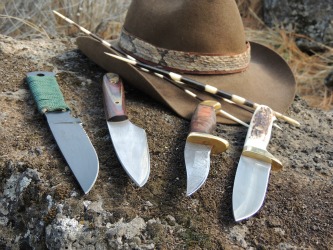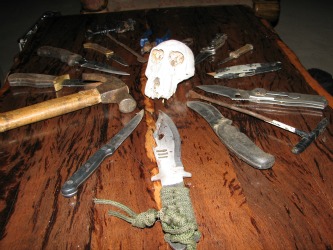Knives we take to Africa
A glimpse into a tracker's backpack and the blades a hunter can put to use on safari.
 Three days before I boarded the plane for South Africa, I got a call from Jim Allen, of Three Sisters Forge, in Bend, Oregon. Jim said he wanted to loan me a knife to take along. This particular blade had already seen action in Afghanistan. Now it was headed back into harm's way. It was no trouble to add another tool to my kit. It packed easily alongside my rifle in the case. But this was not just any knife. It was big.
Three days before I boarded the plane for South Africa, I got a call from Jim Allen, of Three Sisters Forge, in Bend, Oregon. Jim said he wanted to loan me a knife to take along. This particular blade had already seen action in Afghanistan. Now it was headed back into harm's way. It was no trouble to add another tool to my kit. It packed easily alongside my rifle in the case. But this was not just any knife. It was big.
If you want to be called a greenhorn, carry a big belt knife. At over 17 inches from tang to tip, it was the longest edged weapon I had carried since I had to cut brush with a machete as a teenager. There was a moment when one of my partners started to chide me, but he stopped when I handed it over. Something in his combat training past told him this was no knife to trifle with.
Living on the Edge
No matter how much experience you have, when you go someplace new, you’re a tenderfoot. It takes a few days on the ground to get comfortable, to learn the difference between an nyala track and a waterbuck’s, to spot the biggest ram in a herd of impala or catch the shine of kudu horn in the mopane. Over the course of the next 10 days, the big utility blade was used to trim grass for photos, to clear a path for the vehicle, to cut brush for a ground blind, to disable a poacher's snare and to dispatch a black mamba and a baboon. The lesson was not lost on this hunter. A big blade that can do the work of an axe is a welcome addition on any hunt. At the end of the trip, on our last evening on the banks of the Nwanetsi, I reclined with a glass of magic amber liquid. My PH, Wighardt van der Gryp sat down next to me.
"Phineas wants to show you his knife collection." Phineas was Wighardt's assistant, tall, dark, quiet, soft-hearted, a good tracker with a ready smile. I knew him from our first safari. He started in his present career when he was 14, Wighardt said, Now in his late 30's he has a large family that includes three wives. To keep all the mouths fed, he tracks, skins, salts and packs hides from May through October every year.
"Of all the places I have been, all the people I have seen, I know of one guy that can skin faster than him, but that guy puts holes in the skin," Wighardt said.
Phineas sat on his haunches away from the fire and came over when Wighardt called. Soon, he retrieved his backpack and laid out the tools of his trade. As far as I could tell, there was nothing else in the backpack except a water bottle. Some were blades he had been given as gifts from clients, others he had traded for, but each one had a specific reason to be carried. In total, he carried at least 14 edged tools and a hammer on every trip. He arranged the implements in a circle and in a low, soft voice, he explained how he used each one. He started with the hammer and proceeded counter-clockwise. With the hammer, he makes specialized tools out of thick copper wire, tools to separate hide from home in places where knives can't reach, primarily on warthogs and baboons to get into the small places without cutting holes in the skin.
The next was a simple kitchen blade he carries for cooking and eating. After that was a combat style knife with a paracord handle and a curved blade. This one and the next one, a purpose built fixed blade knife, are his favorite skinners. The next item was a length of stiff wire with a flattened point and a wooden handle wrapped in electrical tape. The third skinning knife was a folder that sees duty when the other two knives grow dull. The razor blade he uses for precise straight line cuts on small animals like duiker, monkey and steenbok. After that was a small "separating" blade we might call a caping knife for skinning around the horn.
The next blade showed extensive sharpening, a folder he uses to "cut fat and sinew away from thick skin so salt can penetrate a centimeter." The next blade was a dual edged blade that looked like it could stand a paracord handle wrap. He uses this one to start the ear and skin it out. The next one is a sidecutter he uses for cutting wire. The wire implement is a "spoon" he uses for skinning out ears on animals like kudu and eland. The final three knives - a folder and two fixed with fine, detail-oriented blades - he uses to cut skin in blocks and do the close work around the horns.
Blades to Pack
In truth, a hunter could go on safari and never employ more than a table knife to spread butter on his toast at breakfast. People that like to watch other people work for them don't need to bring a knife. On the other hand, the hunter that travels without a blade is probably not a hunter at all. "The Leatherman took over a lot of knives' positions," Wighardt said. "A guy should bring two multi-tools, one for himself and one for the PH," he joked. There is always something to tighten, always a rattle on the back of the hunting vehicle, scope mounts to secure, fence wire to cut, poaching snares to render useless. And twist-off caps are in short supply. You will want the bottle opener when the sun is up and there are cold drinks in the chilly bin.
If the hunter wants to help with skinning, Wighardt recommends a knife with a gut hook. There are a lot of gut hooks on the market and most are suitable for unzipping small to medium-size antelope. The gut hook is also useful for the initial cuts on back legs and front legs when not needed for a mount. There's a new gut hook tool on the market. On my last hunt, I used the new RaptoRazor - a gut hook with a skinning blade on the obverse angle - to skin out two wild hogs. In less than an hour, I gutted and skinned two hogs while the guide watched. The offset handle is easy to grip and makes it easy to put pulling power into the cutting stroke. The skinning blade is employed on a push stroke.
Wighardt likes to see hunters help in the construction of brushy 'hides.' "We normally build blinds out of wet wood and a saw works well for that." He prefers a cable saw or a folding saw to make quick work of branches and, on game, brisket and bone. "We also use pangas to build blinds and we keep them in the back of the truck."
Like a panga, a good machete can come in handy. I like the SOGfari which measures in at 23.95 inches long, with an 18-inch blade. With a suggested retail of $33.00, it is not a budget breaker. With a straight edge and a saw back, the steel is stainless with a rounded tip to bear the brunt of a downward stroke. As we expect from SOG, there is more to this tool than its cutting edges. Out of the back of the handle juts a spiked tang for scraping, gouging, pounding or worse. The designer left holes in the handle to accommodate a length of parachute cord for twisting, tying and pulling.
On any hunt, there could be brush to clear, trails to blaze or wood to chop. In the extreme, a long blade that is easy to carry and stow alongside a rifle in a gun case, could be put to use to build a shelter or protect oneself in hand-to-claw or hand-to-fang combat. "A guy should bring a knife for cutting jerky, biltong and oranges," Wighardt said. And a celebratory cigar might need to be trimmed preparatory to lighting up. "A seven- or eight-inch folding knife is always useful. If a guy wants to carry a knife for self defense, a fixed blade is a good choice," Wighardt said.
"Another that is very helpful is a thin knife with a strong blade for administering last rites." Such a blade should be six inches long and measure no more than 3/4-inch at its widest. Wighardt said there is always a need for a small knife sharpener in camp and it is helpful to bring along a fire starter tool too. I like to carry a roll of Camo Form from McNett. A reusable heavy-duty fabric wrap, it comes in handy for quieting gear or making an expedient handle for a knife or a panga.
Living on the Edge
There are a lot of reasons to take a knife. One hunter said he only used a blade at the dinner table. Another used a knife and his fire starter to build a fire when his PH and trackers left him alone with the carcass of a buffalo. In the dark of that night, he was glad he had a blade to make tinder and get the blaze going.
Bring at least a multi-tool and a folding knife for camp chores. If you want to help out, bring a machete or a saw and a gut hook and a skinning knife.
From the airport to a tented camp in the Kalahari, somebody will be there to take care of you. Or maybe they won't. Many of us feel unprepared without at least one knife on hand. To my way of thinking, the bush is not a place to be unprepared. I take my best rifle to Africa and blades I can depend on.
# # #
Gary Lewis is an award-winning author, TV host, speaker and photographer. He has hunted and fished in seven countries on three continents and in the islands of the South Pacific. He is a past and current president of the Northwest Outdoor Writers Association and a recipient of NOWA’s Enos Bradner Award.
Contact File
Bitterroot Blades
406-529-0848
www.bitterrootblades.com
Gerber
Myth Field Dress Kit
855-544-0150
www.gerbergear.com
Knives of Alaska
903-786-7366
www.knivesofalaska.com
McNett Corporation
360-671-2227
www.mcnett.com
RaptoRazor
808-638-8281
www.raptorazor.com
SOG Specialty Knives & Tools
888-405-6433
Three Sisters Forge
541-382-7388
-Gary Lewis
Knives in Checked Luggage
When taking knives on safari, the biggest danger to the collection is in transit from airport to airport. Knives, of course, are not allowed in carry-on bags in the passenger compartment. Instead, they should be stored away in a suitcase or in a duffel bag with a lock.
The best bet is to lock knives in a gun case or carry the blades with your bullets in a secure box inside of the checked luggage. For extra insurance, zip-tie or padlock each zipper pull.
-Gary Lewis


